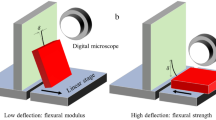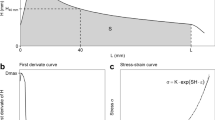Abstract
WOOL fibres have been shown to shorten (super-contract) when held in steam and rapidly stretched and relaxed, or when treated with hot solutions of reagents breaking disulphide bonds, with cold solutions of metal ammonium hydroxides, or with hot solutions of formamide, certain phenols, or lithium bromide (see Alexander and Hudson1).
This is a preview of subscription content, access via your institution
Access options
Subscribe to this journal
Receive 51 print issues and online access
$199.00 per year
only $3.90 per issue
Buy this article
- Purchase on Springer Link
- Instant access to full article PDF
Prices may be subject to local taxes which are calculated during checkout
Similar content being viewed by others
References
Alexander, P., and Hudson, R. F., “Wool: Its Chemistry and Physics”, 75 (Chapman and Hall, London, 1954).
Alexander, P., Ann. N.Y. Acad. Sci., 53, 653 (1951).
Lennox, F. G., Biochim. Biophys. Acta, 3, 170 (1949).
Jordan Lloyd, D., and Garrod, M. E., Trans. Farad. Soc., 44, 441 (1948).
Beauregard, L. J., Brown, H. E., and Harris, N., Text. Res. J., 23, 642 (1953).
Crewther, W. G., Proc. Int. Wool Text. Res. Conf. Aust., 1955, C, 227 (1956).
Author information
Authors and Affiliations
Rights and permissions
About this article
Cite this article
CREWTHER, W., DOWLING, L. Effect of Electrolytes on the Rate of ‘Supercontraction’ of Wool Fibres. Nature 178, 544–545 (1956). https://doi.org/10.1038/178544b0
Issue Date:
DOI: https://doi.org/10.1038/178544b0
This article is cited by
-
Chemische und physikalische Untersuchungen an Keratinfasern
Kolloid-Zeitschrift & Zeitschrift für Polymere (1970)
-
Zur Superkontraktion von α-Keratinfasern in Lithiumbromidlösungen: Über die Korrelation zwischen Längenänderung und kalorischen Effekten
Kolloid-Zeitschrift & Zeitschrift für Polymere (1967)
-
Untersuchungen der Adsorption von Lithiumbromid an Austral-A-Wolle
Kolloid-Zeitschrift & Zeitschrift für Polymere (1966)
Comments
By submitting a comment you agree to abide by our Terms and Community Guidelines. If you find something abusive or that does not comply with our terms or guidelines please flag it as inappropriate.



